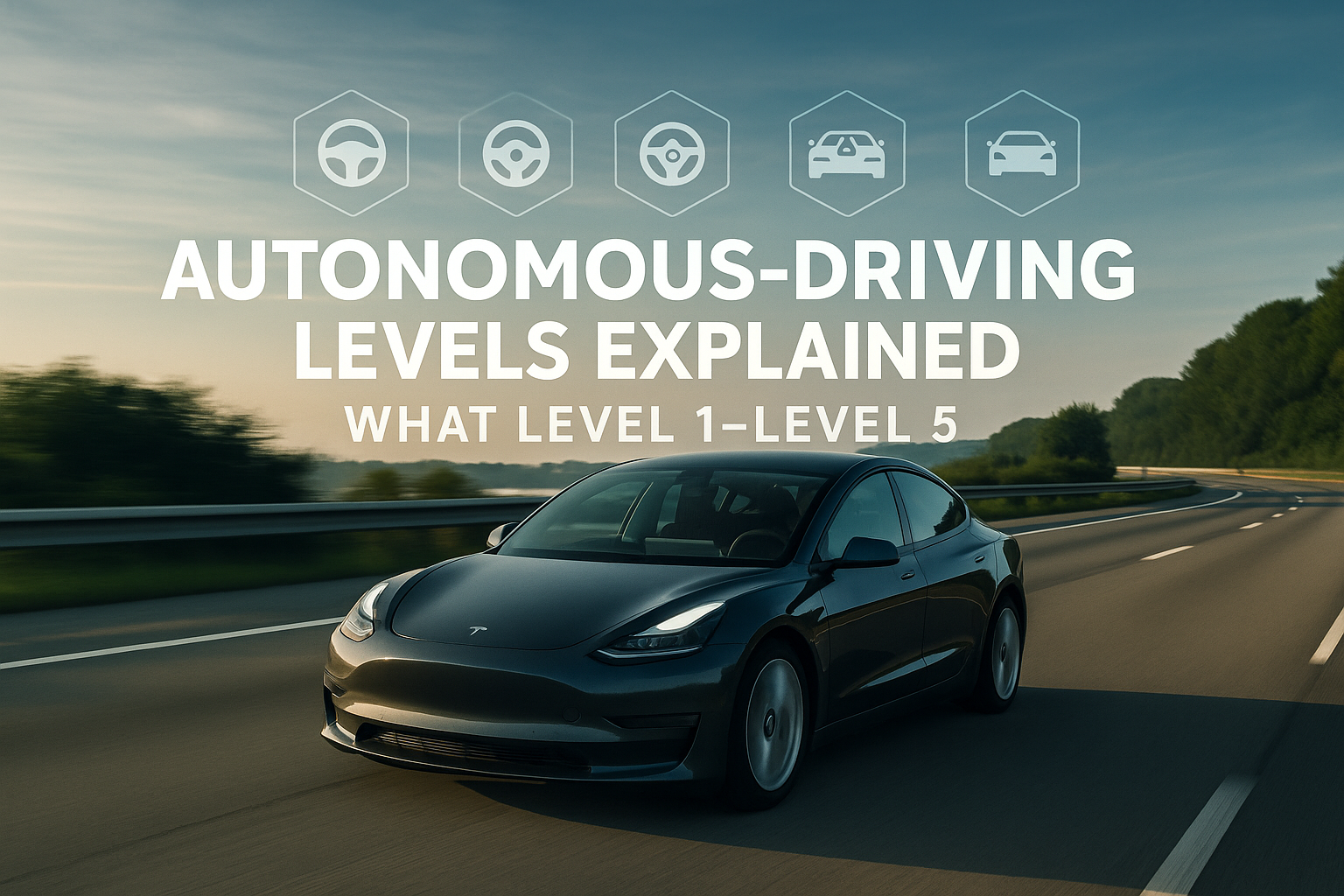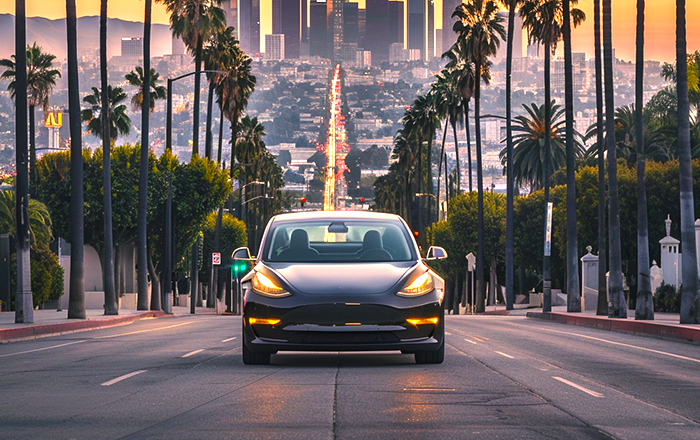Autonomous-Driving Levels Explained: What Level 1–Level 5

Experiencing Real-World Self-Driving in the United States
Hi, I’m Suzuki from Eco Drive.
Let’s take a quick look at how far self-driving tech has come. The pace is wild—every January at CES in Las Vegas, fresh autonomous-driving demos steal the show.
Prefer video? Check out the clip below for real-world footage of Tesla’s FSD in action.
All of the videos have Japanese audio, but English subtitles are available.
When watching, please turn on the subtitles to follow along in English.
What “Levels” of Autonomy Mean
To really gauge how self-driving cars are evolving, you first need to know the autonomy levels—a five-step scale that measures how much of the driving the car can handle on its own.
Each level marks a concrete jump in capability, so understanding where current models sit tells you just how close we are to a hands-off future.
With that in mind, here’s a quick rundown of what each level means.
Levels 1–5 at a Glance
Self-driving tech is graded on a five-step ladder:
- Level 1 – Driver Assistance
Basic aids like adaptive cruise or lane-keep; you’re still in charge. - Level 2 – Partial Automation
The car can steer and control speed at the same time, but hands and eyes stay engaged. - Level 3 – Conditional Automation
It drives itself under set conditions (usually highways) yet expects you to jump in when asked. - Level 4 – High Automation
True self-driving inside a mapped “geo-fence”—think robo-shuttles in certain cities. - Level 5 – Full Automation
Go anywhere, any time—no human input required.
So far, Level 4 vehicles can run solo only within those predefined zones, while Level 5 remains the endgame: unrestricted, go-anywhere autonomy.
What’s Actually on the Road Today? Level 3
Right now the most advanced autonomy you can legally use on public roads is Level 3.
In a Level 3 car the system handles every driving task, but only under set conditions—typically on limited-access highways—and it can tell you to take over at any moment. Hands have to stay on the wheel, eyes on the road.
So yes, Level 3 is on sale, but genuine “hands-off, eyes-off” cruising is still ahead. As the tech matures, though, Levels 4 and 5 will edge closer to reality.
Examples you can buy (in limited markets) include Mercedes-Benz’s Drive Pilot-equipped E-Class and Honda’s Legend with Traffic Jam Pilot.
My Take After Using Tesla FSD

Here’s what self-driving looks like in real life, based on my own Tesla.
Although Autopilot and Full Self-Driving (FSD) are only certified as Level 2, in day-to-day use they feel just a hair shy of Level 3.
On my commute—both ways—the car does almost the whole drive for me. I still rest my hands on the wheel and stay alert, but steering, braking, lane changes, even most merges are handled by the computer.
Letting the car handle more of the workload
As long as I keep a light grip on the wheel, my Tesla handles the rest—steering, braking, and accelerating right to my doorstep.
It even tackles the fiddly stuff: stopping for lights and stop signs, sliding over for lane changes when the nav says so, and rerouting on the fly if traffic backs up.
After living with this setup, I’m convinced truly self-driving cars are closer than most people think. The tech gets better by the day, the error rate keeps dropping, and the whole idea of what it means to “drive” is already starting to change.
Still Room to Improve
FSD still has its “wait, what?” moments.
It might inch toward oncoming traffic in a single-lane construction zone, or decide to pass a slow car even though I’m signaling a left turn—moves no human would make.
Elon Musk says those quirks should disappear once Tesla swaps the current v11 code for its brand-new AI stack.
That upgrade—Version 12, now rolling out—is already live, and I’ll have a hands-on review soon.
With over-the-air updates landing this fast, the outlook for self-driving feels bright, and Tesla’s ever-evolving software keeps redefining what it means to be behind the wheel.
More on Tesla FSD in this video:
Why Expectations for Tesla FSD Keep Growing
Personally, I’m bullish on Tesla’s self-driving tech—especially Full Self-Driving (FSD).
One big reason is Tesla’s unmatched data trove.
Roughly 300,000 FSD-equipped Teslas are logging real-world miles, dwarfing any other automaker’s dataset.
Feeding that firehose of data into Tesla’s AI should let the company push autonomy forward faster than anyone else.
Most production cars top out at Level 3 (conditional automation) right now, but Tesla may be the first to leap beyond it.
High Hopes for Better Accuracy After AI Integration
Tesla’s new Version 12 drops in a completely rebuilt AI stack, and it just might push FSD past Level 3 into even higher autonomy.
Launched in 2024, the update is already generating serious buzz.
The road ahead for FSD looks bright—each tech jump should make the system smarter and smoother.
I can’t wait to see how this next-gen release transforms everyday driving.
Will Robotaxis Become Reality?

Elon Musk’s robotaxi vision offers a vivid glimpse of how we might get around tomorrow.
Picture this: whenever you’re not using it, your self-driving Tesla heads out on its own, picks up riders, and earns cash.
While you’re at work—or fast asleep—the car is hustling instead of sitting idle.
Driverless taxis are already roaming San Francisco and Los Angeles, and initial data show their crash rates are way below those of human drivers.
That hints at both safer roads and cheaper rides.
One day, simply owning a car could become a tidy source of passive income.
Key Challenges Ahead
Sure, the robotaxi concept raises a ton of open questions.
Who’s on the hook if a driverless car crashes? How will insurance have to adapt?
The industry still has to iron out puzzles like these as it scales.
As someone who already commutes in a semi-autonomous car, I’m watching the tech—and its ripple effects—with keen interest.
If robotaxis do go mainstream, they could upend not just mobility but the whole idea of car ownership itself.
Try Tesla FSD Yourself with Eco Drive
You can’t test Tesla’s Full Self-Driving in Japan, but Eco Drive lets you rent a Tesla with FSD right here in the States.
All of our cars are already running Version 12, so you can try the very latest self-driving tricks straight away.
We launched this service so drivers can experience Tesla autonomy first-hand and tell us what they think.
A deep-dive review of FSD Version 12 is coming soon—stay tuned.
In the meantime, check out an interview with someone who’s already taken the car for a spin.
A detailed Version 12 review is coming soon—stay tuned.
Our Services
We offer comprehensive automotive solutions—buy, sell, rent, and repair in one place.
Car Sales
Browse our lineup of quality used cars with transparent pricing and up to a two-year warranty on select models.
View InventoryAuto Repair
Get expert service from our certified Toyota Master Mechanic. We primarily service Toyota vehicles.
Schedule ServiceTrade-in / Sell
We pay top dollar for your vehicle—especially hybrids. Count on fair, transparent appraisals.
Get EstimateCar Rentals
Choose between fuel-saving hybrid rentals and a Tesla with Full Self-Driving Capability—both at competitive rates.
Reserve Now





